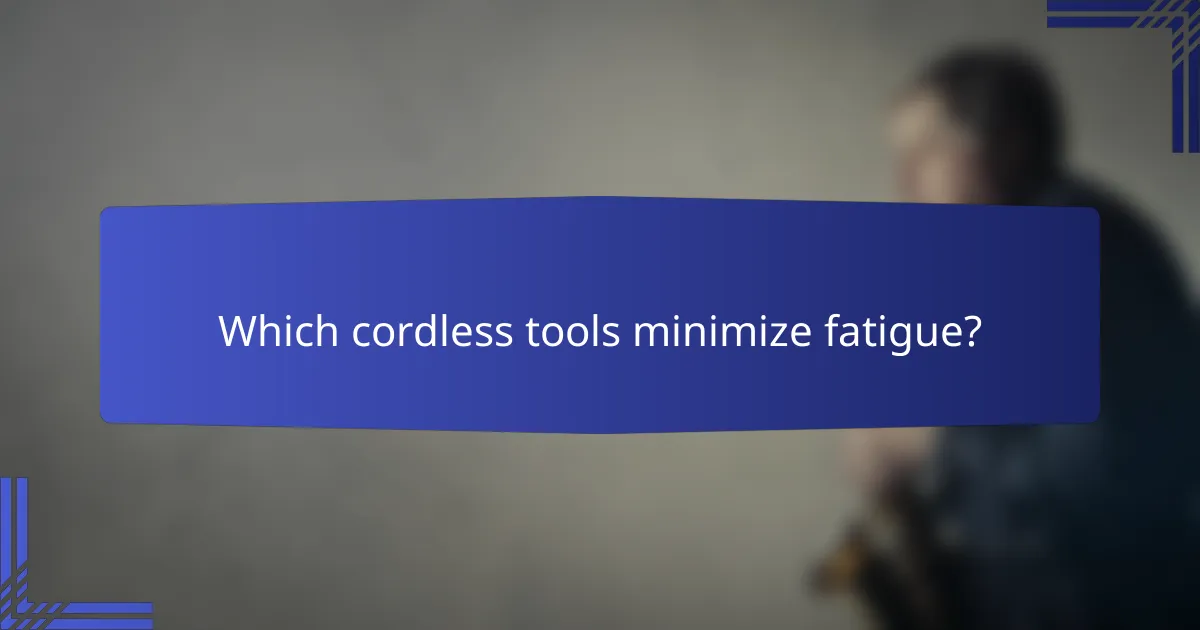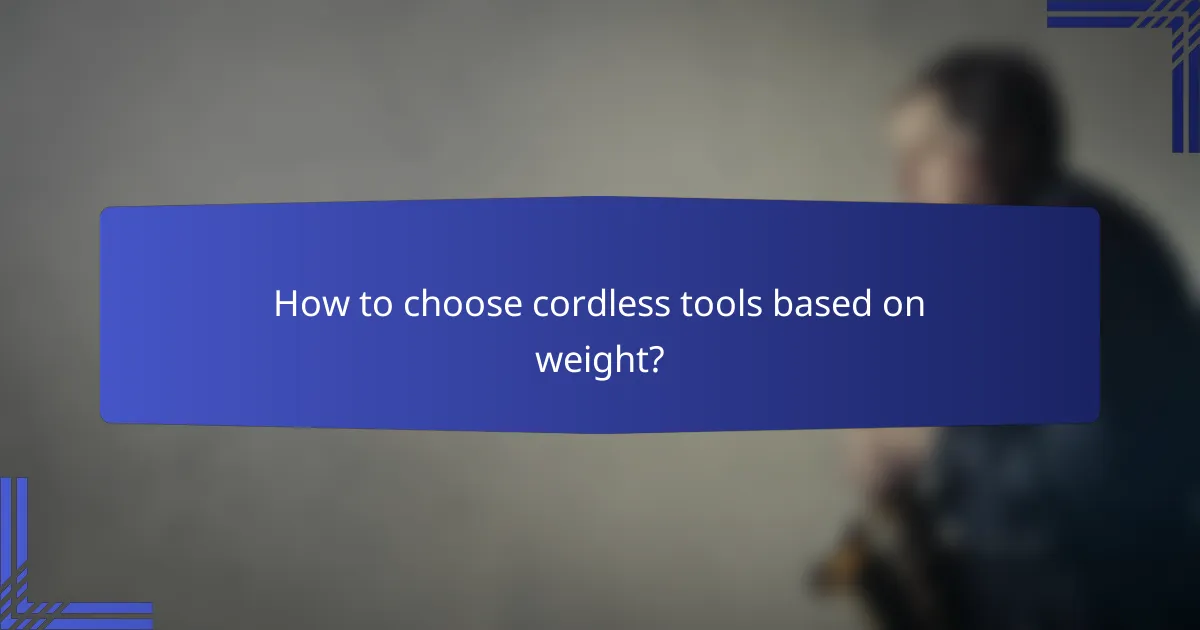The weight of cordless tools plays a crucial role in user fatigue, precision, and control. Heavier tools may offer stability but can lead to increased strain during extended use, while lighter options enhance maneuverability and comfort. By prioritizing lightweight, ergonomically designed tools, users can achieve greater efficiency and accuracy in their tasks.

How does weight affect user fatigue with cordless tools?
The weight of cordless tools significantly impacts user fatigue, as heavier tools can lead to increased strain during prolonged use. Lighter tools generally allow for longer operation times with less physical stress, enhancing user comfort and efficiency.
Lightweight tools reduce fatigue
Lightweight cordless tools are designed to minimize user fatigue, making them ideal for extended tasks. Tools weighing around 1 to 3 kg are often easier to handle, allowing users to work longer without experiencing discomfort. This is particularly beneficial for tasks that require precision and control, as less weight enables better maneuverability.
For instance, a lightweight drill can be used for hours without significant strain, making it suitable for both professional and DIY projects. Users often report feeling less tired and more focused when using tools that are easy to lift and operate.
Heavy tools increase strain
Conversely, heavier cordless tools can lead to increased physical strain and fatigue, especially during prolonged use. Tools weighing over 3 kg may cause discomfort in the arms, shoulders, and back, leading to decreased productivity and potential injury. Users may find themselves taking more frequent breaks to alleviate discomfort, which can disrupt workflow.
For example, a heavy impact wrench may be necessary for certain tasks, but its weight can lead to fatigue after just a short period of use. It’s crucial to balance the need for power with the tool’s weight to avoid excessive strain.
Optimal weight for extended use
The optimal weight for cordless tools typically falls between 1.5 to 3 kg, providing a balance between power and manageability. This weight range allows users to maintain control and precision while reducing the risk of fatigue. When selecting a tool, consider both its weight and the duration of use to ensure comfort.
Additionally, ergonomic designs can enhance the usability of heavier tools, making them feel lighter and easier to handle. Look for features like padded grips and balanced weight distribution to improve comfort during extended tasks.

What is the impact of weight on precision and control?
The weight of cordless tools significantly influences precision and control during use. Heavier tools can provide stability, while lighter options enhance maneuverability, affecting user fatigue and overall performance.
Heavier tools provide stability
Heavier cordless tools often offer greater stability, which can improve precision in tasks requiring fine detail, such as drilling or cutting. The added weight helps to minimize vibrations, allowing for steadier movements and more accurate results.
For instance, a heavier drill may be preferable for tasks like installing anchors in concrete, where stability is crucial. However, the trade-off is that prolonged use can lead to user fatigue, especially if the tool is held overhead or in awkward positions.
Lighter tools enhance maneuverability
Lighter cordless tools are easier to handle, making them ideal for tasks that require frequent repositioning or extended use. Their reduced weight allows users to work for longer periods without experiencing significant fatigue, which is particularly beneficial in overhead applications or tight spaces.
For example, a lightweight impact driver can be advantageous when working on a ladder or in confined areas, where agility is essential. However, the trade-off may be a slight reduction in stability, which can affect precision in certain applications.
Balance affects control
The balance of a cordless tool plays a critical role in user control and comfort. A well-balanced tool distributes weight evenly, reducing strain on the user’s wrist and hand, which enhances overall handling and precision.
When selecting a tool, consider how it feels in your hand. A tool that feels top-heavy may lead to fatigue and decreased accuracy over time. Testing various models can help identify the best balance for your specific needs, ensuring both comfort and control during use.

Which cordless tools minimize fatigue?
Cordless tools that minimize fatigue are typically lightweight, ergonomically designed, and feature efficient battery systems. These tools allow users to work longer with less strain, enhancing precision and control during tasks.
DeWalt DCD791D2 20V Max
The DeWalt DCD791D2 is known for its lightweight design, weighing around 3.4 pounds, which significantly reduces user fatigue during extended use. Its compact size allows for easy maneuverability in tight spaces, making it ideal for both professional and DIY projects.
This drill features a brushless motor that provides high efficiency and longer runtime, which means less time spent recharging. The ergonomic handle is designed for comfort, allowing for better grip and control, minimizing the risk of strain.
Milwaukee M18 Fuel
Milwaukee’s M18 Fuel series is engineered for performance and comfort, with tools weighing approximately 3.5 pounds. The combination of a lightweight design and advanced battery technology helps reduce fatigue, enabling users to work longer without discomfort.
This tool features a POWERSTATE brushless motor that delivers more power and longer life, which is crucial for maintaining precision in demanding tasks. The REDLINK PLUS intelligence system ensures optimal performance and protects against overload, further enhancing user control.
Makita XFD131 18V
The Makita XFD131 is another excellent choice, weighing about 3.8 pounds, which makes it easy to handle for extended periods. Its balanced design helps distribute weight evenly, reducing strain on the user’s wrist and arm.
Equipped with a brushless motor, the XFD131 provides efficient power and longer battery life, allowing users to focus on their work rather than frequent recharging. The rubberized grip enhances comfort and control, making it suitable for various applications without causing fatigue.

What weight range is ideal for cordless tools?
The ideal weight range for cordless tools typically falls between 1.5 to 3.5 kilograms. This range balances user fatigue with control and precision, allowing for effective operation over extended periods.
Optimal range for professionals
For professionals, cordless tools weighing between 2 to 3 kilograms are often optimal. This weight allows for sufficient power while minimizing fatigue during long work sessions. Tools at this weight are generally easier to maneuver, providing better precision and control.
Additionally, professionals should consider the specific tasks they perform. For instance, heavier tools may be beneficial for demanding applications like drilling through tough materials, while lighter options are preferable for detailed work or overhead tasks.
Recommended weight for DIY users
DIY users typically benefit from cordless tools weighing between 1.5 to 2.5 kilograms. This range is manageable for most home projects, allowing for ease of use without excessive strain. Lighter tools can enhance comfort, especially for those who may not be accustomed to heavy equipment.
When selecting tools, DIY users should focus on versatility and ease of handling. A tool that feels comfortable and balanced in hand will likely yield better results, whether for simple repairs or more complex projects.

How to choose cordless tools based on weight?
When selecting cordless tools, weight is a crucial factor that affects user fatigue, precision, and control. Lighter tools generally reduce fatigue during prolonged use, while heavier models may offer better stability and power for specific tasks.
Evaluate task requirements
Understanding the specific tasks you will perform with cordless tools is essential for choosing the right weight. For instance, tasks requiring precision, such as detailed woodworking or electronics work, may benefit from lighter tools that allow for better maneuverability. Conversely, heavy-duty tasks like drilling into concrete might necessitate a more robust tool that can handle the strain.
Consider the duration and frequency of use as well. For occasional tasks, a heavier tool may not be a significant drawback, but for daily use, lighter options can help minimize fatigue and improve overall productivity.
Consider user strength and endurance
User strength and endurance play a vital role in determining the appropriate weight for cordless tools. Individuals with greater physical strength may manage heavier tools effectively without experiencing excessive fatigue. However, those with less strength or endurance should opt for lighter models to maintain control and comfort during use.
It can be helpful to test tools in-store or rent them before purchasing. This hands-on experience allows users to assess how different weights feel during operation, ensuring they select a tool that matches their physical capabilities and the demands of their projects.

What are the latest trends in lightweight cordless tools?
Lightweight cordless tools are increasingly favored for their ease of use and reduced user fatigue. Recent innovations focus on enhancing battery performance and utilizing advanced materials to minimize weight while maintaining power and precision.
Advancements in battery technology
Battery technology has made significant strides, particularly with lithium-ion and newer solid-state batteries. These advancements allow for lighter batteries that provide longer run times and faster charging, which is crucial for maintaining productivity without frequent interruptions.
Many modern cordless tools now feature smart battery management systems that optimize energy usage, extending battery life and performance. Users should look for tools that offer rapid charging capabilities, which can reduce downtime during projects.
Materials reducing overall weight
Manufacturers are increasingly using advanced materials like carbon fiber and high-strength plastics to create lighter tool bodies. These materials not only reduce weight but also enhance durability, making tools easier to handle without sacrificing performance.
When selecting cordless tools, consider models that incorporate these lightweight materials, as they can significantly decrease user fatigue during extended use. Additionally, tools designed with ergonomic grips can further improve control and precision, making tasks more manageable.
